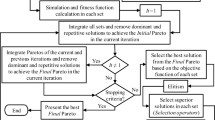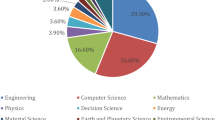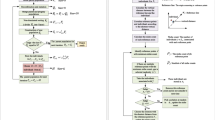Abstract
In recent years, multi-objective evolutionary algorithms (MOEAs) have been widely used to handle various water resources problems. One challenge within MOEAs’ applications is a lack of understanding on how various operators alter a MOEA’s behavior to achieve its final performance (i.e., MOEAs are black-boxes to practitioners), and hence it is difficult to select the most appropriate operators to ensure the MOEA’s best performance for a given real-world problem. To address this issue, this study proposes the use of the run-time measure metrics to reveal the underlying searching behavior of the MOEA’s operators. The proposed methodology is demonstrated by the non-dominated sorting genetic algorithm II (NSGA-II, a widely used MOEA in water resources) with five commonly used crossover operators applied to six water distribution system design problems. Results show that the simulated binary crossover (SBX) and the simplex crossover (SPX) operators possess great ability in extending the front and finding Pareto-front solutions, respectively, while the naive crossover (NVX) strategy exhibits the overall worst performance in identifying optimal fronts. The obtained understanding on the operators’ searching behavior not only offers guidance for selecting appropriate operators for real-world water resources problems, but also builds fundamental knowledge for developing more advanced MOEAs in future.







Similar content being viewed by others
References
Artita KS, Kaini P, Nicklow JW (2013) Examining the possibilities: generating alternative watershed-scale BMP designs with evolutionary algorithms. Water Resour Manag 27(11):3849–3863
Bi W, Dandy GC, Maier HR (2015) Improved genetic algorithm optimization of water distribution system design by incorporating domain knowledge. Environ Model Softw 69(0):370–381
Chau KW, Wu CL (2010) A hybrid model coupled with singular spectrum analysis for daily rainfall prediction. J Hydroinf 12(4):458–473
Chen XY, Chau KW, Busari AO (2015) A comparative study of population-based optimization algorithms for downstream river flow forecasting by a hybrid neural network model. Eng Appl Artif Intell 46(PA):258–268
Deb K, Agrawal RB (2000) Simulated binary crossover for continuous search space. Comput Syst 9(3):1–15
Deb K, Pratap A, Agarwal S, Meyarivan T (2002a) A fast and elitist multiobjective genetic algorithm: NSGA-II. IEEE Trans Evol Comput 6(2):182–197
Deb K, Anand A, Joshi D (2002b) A computationally efficient evolutionary algorithm for real-parameter optimization. Evol Comput 10(4):371–395
Gholami V, Chau KW, Fadaee F, Torkaman J, Ghaffari A (2015) Modeling of groundwater level fluctuations using dendrochronology in alluvial aquifers. J Hydrol 529:1060–1069
Hadka D, Reed P (2012) Diagnostic assessment of search controls and failure modes in many-objective evolutionary optimization. Evol Comput 20(3):423–452
Higuchi, T., Tsutsui, S. and Yamamura, M. (2000). Theoretical analysis of simplex crossover for real-coded genetic algorithms. Proceedings of the 6th International Conference on Parallel Problem Solving from Nature, pp. 365–374
Karamouz M, Nazif S, Sherafat MA, Zahmatkesh Z (2014) Development of an optimal reservoir operation scheme using extended evolutionary computing algorithms based on conflict resolution approach: a case study. Water Resour Manag 28(11):3539–3554
Kollat JB, Reed PM (2007) A computational scaling analysis of multiobjective evolutionary algorithms in long-term groundwater monitoring applications. Adv Water Resour 30(3):408–419
Maier HR et al (2014) Evolutionary algorithms and other metaheuristics in water resources: current status, research challenges and future directions. Environ Model Softw 62:271–299
Nicklow J, Reed P, Savic D, Dessalegne T, Harrell L, Chan-Hilton A, Karamouz M, Minsker B, Ostfeld A, Singh A (2010) State of the art for genetic algorithms and beyond in water resources planning and management. J Water Resour Plan Manag 136(4):412–432
Ono, I. and Kobayashi, S. (1997). A real coded genetic algorithm for function optimization using unimodal normal distributed crossover. Proceedings of the 7th International Conference on Genetic Algorithms, East Lansing, MI, USA, July 19–23, 1997, pp. 246–253
Taormina R, Chau KW (2015) Data-driven input variable selection for rainfall–runoff modeling using binary-coded particle swarm optimization and extreme learning machines. J Hydrol 529:1617–1632
Wang WC, Chau KW, Xu DM, Chen XY (2015a) Improving forecasting accuracy of annual runoff time series using ARIMA based on EEMD decomposition. Water Resour Manag 29(8):2655–2675
Wang Q, Guidolin M, Savic D, Kapelan Z (2015b) Two-objective design of benchmark problems of a water distribution system via MOEAs: towards the best-known approximation of the true Pareto front. J Water Resour Plan Manag 141(3):04014060
Yazdi J (2016) Decomposition based multi objective evolutionary algorithms for Design of Large-Scale Water Distribution Networks. Water Resour Manag 30(8):2749–2766
Zecchin AC, Simpson AR, Maier HR, Marchi A, Nixon JB (2012) Improved understanding of the searching behavior of ant colony optimization algorithms applied to the water distribution design problem. Water Resour Res 48(9):W09505
Zheng F, Zecchin A, Simpson A (2013) Self-adaptive differential evolution algorithm applied to water distribution system optimization. J Comput Civ Eng 27(2):148–158
Zheng F, Zecchin A, Maier H, Simpson A (2016) Comparison of the searching behavior of NSGA-II, SAMODE, and Borg MOEAs applied to water distribution system design problems. J Water Resour Plan Manag 142(7):04016017
Zitzler E, Thiele L (1999) Multiobjective evolutionary algorithms: a comparative case study and the strength Pareto approach. IEEE Trans Evol Comput 3(4):257–271
Author information
Authors and Affiliations
Corresponding author
Additional information
Highlights
• Proposed metrics successfully reveal the underlying searching behavior of NSGA-II’s operators
• NSGA-II operators efficiently drive the fronts initially, followed by slow improvements.
• SBX and SPX are robust in finding the fronts for WDS design problems
• SBX possess great ability in extending the front and NVX showed overall worst performance
Rights and permissions
About this article
Cite this article
Zheng, F., Qi, Z., Bi, W. et al. Improved Understanding on the Searching Behavior of NSGA-II Operators Using Run-Time Measure Metrics with Application to Water Distribution System Design Problems. Water Resour Manage 31, 1121–1138 (2017). https://doi.org/10.1007/s11269-016-1564-7
Received:
Accepted:
Published:
Issue Date:
DOI: https://doi.org/10.1007/s11269-016-1564-7




